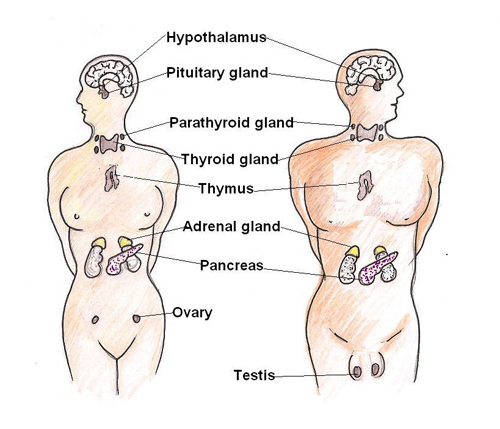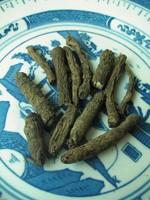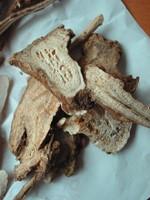Chinese Herbs with Hormonal Effects
In traditional Chinese medicine (TCM), the kidney system has a wider function than that of the Western anatomical kidney, regarding it as the root of life and the origin of our individuality as human beings. TCM considers the kidney to be the most important organ of the body since it performs functions pertaining to the genital, urinary, endocrine, skeletal, blood, and central nervous systems.
One of the main tasks of the kidney in TCM is controlling the growth and development and reproduction of the body. Besides the sex glands, other endocrine glands like hypothalamus, pituitary, adrenal and thyroid are all involved actively in the growth and development of the body, as a result, according to the TCM understanding of the kidney, the modern concept of the endocrine system belongs to part of TCM kidney functioning.
 The endocrine glands of the body
The endocrine glands of the body
The endocrine system produces and secretes hormones, which are chemical messengers for coordinating physiological activities. The hypothalamus and pituitary, which are located in the brain, act as a higher control; they regulate the secretions of the adrenal glands, thyroid, breasts, ovaries, uterus, testicles and prostate. The secretions then bind to specific receptors in the target structures triggering various physiological actions. Some of the endocrine glands work together and form a complex regulating network named "functional axis", which are important to maintain the normal physiology of the body. The three commonly describe functional axes are the hypothalamus-pituitary-adrenal, the hypothalamus-pituitary-thyroid and the hypothalamus-pituitary-gonad. Disturbances in the regulating systems lead to endocrine diseases such as hyperthyroidism, endometriosis, missed periods and infertility. Western medicine tries to solve these conditions by hormonal therapies, while TCM will use a wide variety of herbs to regulate the endocrine functions. Some of the herbs and their hormonal effects are listed below.
1. Hypothalamus-pituitary-adrenal axis
This functional axis controls stress reactions and regulates bodily processes including digestion, the immune system, mood and emotions, energy storage and expenditure. Dysfunctions of this axis can lead to mood disorders and functional illnesses, such as anxiety, insomnia, post-traumatic stress disorder, chronic fatigue syndrome, irritable bowel syndrome, and alcoholism.
Chinese herbs that can promote or activate this functional axis include:
Processed and dried rhemannia rhizome, pilose asiabell root, liquorice root, poria, ginseng leaf, Chinese wolfberry, ephedra, morinda root, dodder seed, tuber fleeceflower root (he shou wu), reishi mushroom, common monkshood daughter root, cassia bark, cistanche, bupleurum root, corydalis rhizome, and radish seed.
Chinese herbs that can inhibit this functional axis include:
Dried ginger, kudzu root, baical skullcap root, figwort root, cardamon seed, pinellia tuber, anemarrhena rhizome, notoginseng, Siberian solomonseal rhizome, and cordyceps.
For clinical cases like abnormal heartbeat, unstable blood pressure, respiratory or inflammatory conditions, the above inhibiting herbs should be considered. Anemarrhena rhizome is an essential herb for any TCM syndrome due to virtual fire.
2. Hypothalamus-pituitary-thyroid axis
This axis mainly controls the body's metabolism, the rate at which the body converts food and oxygen into energy. Under-functioning will cause weight gain and fatigue, and may be attributed to aging, missed periods or depression. Hyper-functioning will cause nervousness, insomnia and heart palpitations.
Chinese herbs that can promote or activate this functional axis include:
Morinda root, white mustard seed, tuber fleeceflower root (he shou wu), corydalis rhizome, Rhizoma Dioscoreae Bulbiferae (huang yao zi), reed rhizome, kelp/seaweed, and Acanthopanax brachypus Harms.
Chinese herbs that can inhibit this functional axis include:
Radish seed, anemarrhena rhizome, processed rhemannia rhizome, Plastrum Testudinis (gui jia), prickly acanthopanax root, and Semen Gossypium (mian hua zi).
3. Hypothalamus-pituitary-gonadal axis
This axis maintains the normal physiology of the female and male reproductive systems. Endocrine disorders in a woman's reproductive system can lead to menstrual problems, endometriosis, delayed puberty, polycystic ovary syndrome, and sexual problems as well as infertility and breast problems.
Ingredients that can promote the sex glands and increase the level of estrogen include:
Common curculigo rhizome, epimedium, Acanthopanacis Senticosi (ci wu jia), glossy privet fruit, liquorice root, ginseng, Fructus Tribuli (ci ji li), fennel, Cortex Acanthopanacis Radicis (wu jia pi), Chinese senega, honey, ant, hairy deer antler, gecko and sea horse
Chinese herbs that can increase the level of estrogen include:
Black soybean, Chinese rhubarb, red sage root, kudzu root, reed rhizome, common cnidium fruit, nutgrass flatsedge rhizome, psoralea, achyranthes root, Fructus Viticis Cannabifoliae (mu jing zi), seven-lobed yam rhizome, Japanese flowering fern rhizome, large blister beetle and astragalus root.
Ingredients that can increase the level of androgen include:
Cordyceps, asparagus, green onion stalk, deer antler glue, silk moth, raspberry fruit, cassia bark, cuttlefish bone, musk, pipe fish and starfish.
It is also said that sea cucumber has a dual effect on the level of androgen.
Chinese herbs that can decrease the level of androgen include:
Red sage root, Semen Trigonellae (hu lu ba), and Folium Vaccinii Vitis-idaeae (yue ju ye).
Some ingredients can activate the sperm such as:
Ginseng, dried tangerine peel, dodder seed, and Fructus Galangae (hong dou kou).
However, some herbs can kill sperm such as:
Sopora root, Chinese pulsatilla root, Radix Tripterygii Wilfordii (lei gong teng), Radix Gossypium (main hua gen), Herba Agrimoniae (xian he cao), bitter melon and earthworm.
Enlargement of the prostate and prostate cancer are increasing risk of men's health, two herbs that can help depress the level of prostaglandin are Fructus Alpinae Oxyphylae (yi zhi ren) and Rhizoma Ligustici (gao ben). On the other hand, herbs that can increase the level of prostaglandin are:
Radix Trichosanthis (tian hua fen), dried ginger, Bulbus Allii Macrostemi (xia bai), white peony root, pagoda tree flower bud, and Cortex Araliae Elatae (ci long ya).
The effects of the herbs mentioned in this section have mostly been demonstrated through in-vitro or in-vivo studies; further clinical studies are necessary to evaluate their actions in the human body. It should also be kept in mind that TCM physicians rarely use herbs singly, as the herbs may contain potent or multiple active components; they are often given as one ingredient in a prescription so as to accentuate the therapeutic strengths and reduce the undesirable effects of that particular herb.
 |
 |


